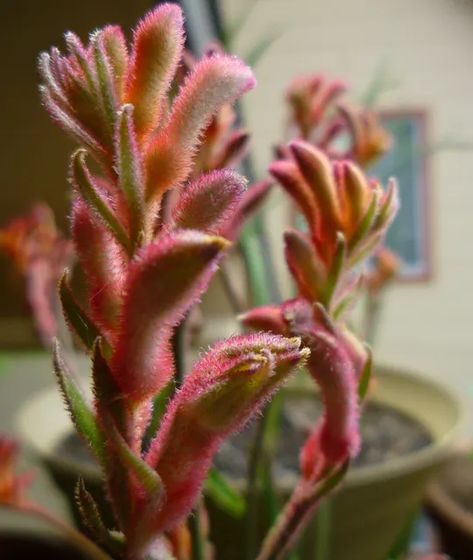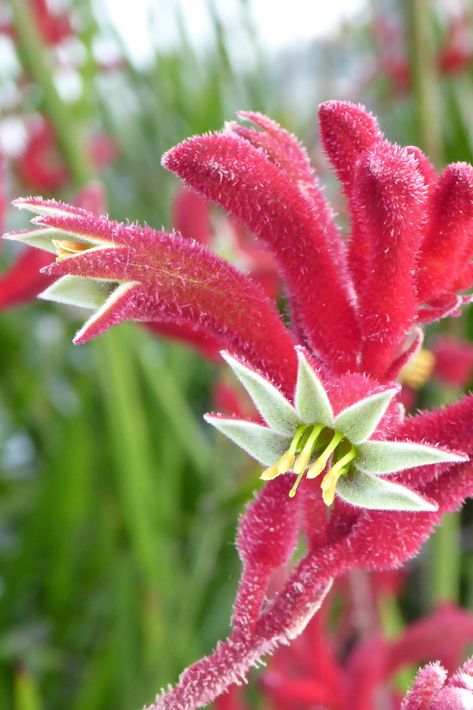The genus Angiozanthos, which includes 11 species and numerous subspecies of flowering plants, is indigenous to Australia and is known as kangaroo paw. These plants resemble daylilies or amaryllis plants in their long, slender, arching leaves. The peculiar tubular blossoms resemble animal paws because they are covered in velvety fuzz and grow on stalks in fan-like rows. The blossoms are colored in a variety of hues, such as purple, yellow, orange, and red.
Plants with kangaroo paws grow fairly quickly and don’t need much care.
Kangaroo Paw Plant Overview

| Common Name | Kangaroo paw, cat’s paw |
| Botanical Name | Anigozanthos spp. |
| Family | Haemodoraceae |
| Plant Type | Perennial, herbaceous |
| Mature Size | 2-10 ft. tall, 1-2 ft. wide |
| Sun Exposure | Full |
| Soil Type | Sandy, moist, well-drained |
| Soil pH | Acidic, neutral |
| Bloom Time | Spring, summer, fall |
| Flower Color | Red, orange, yellow, pink, purple, white |
| Hardiness Zones | 10-11 (USDA) |
| Native Area | Australia |
Kangaroo Paw Plant Care

A kangaroo can grow in a container or in the ground. The diminutive varieties work particularly well in containers. In either case, having soil that drains quickly is essential to plant growth.
Kangaroo paw is a perennial that may be planted in your garden and will come back year after year if you live in USDA hardiness zones 10 through 11. If you reside in a colder climate, though, you’ll either need to bring your kangaroo paw indoors for the winter or treat your plants like annuals, allowing them to die in the fall and then planting new ones in the spring.
Light Requirements
Full light is ideal for the growth of these plants. For optimal growth and flowering, kangaroo paw plants require six hours of direct sunlight on most days. Even the bright afternoon sun’s powerful rays will not harm them. Conversely, insufficient light can make tall plants topple over and reduce the amount of blooms produced.
Soil
Although kangaroo paws like sandy soil with a slightly acidic pH (5.8 to 6.5), they can thrive in a range of soil types as long as there is adequate drainage.
Watering
Although kangaroo paw plants can withstand some drought, they need a reasonable level of soil moisture. Plants might die from root rot brought on by soggy soil. Therefore, don’t water until the top few inches of soil are completely dry. While most of the blooming happens in the spring and summer, kangaroo paw does benefit from a little extra watering.
Temperature and Environment

These are heat-loving plants, and frost can be deadly. They enjoy temperatures that are in the neighborhood of 70 to 80 degrees Fahrenheit. In addition, they naturally prefer dry environments, however they may also withstand mild dampness.
Fertilization
Because they are not heavy feeders, kangaroo paw plants do not require frequent fertilization. To encourage healthy growth, add a cup or two of compost to the soil in the spring before the flower stems appear.
Types of Kangaroo Paw Plants
Breeders have attempted to produce cultivars with greater disease resistance and more visually appealing blossoms from the natural species. Popular varieties of kangaroo paw plants include:
- Red and green kangaroo paw (Anigozanthos manglesii): This plant, which yields green and red blooms and stems, is the floral symbol of Western Australia.
- Tall kangaroo paw (Anigozanthos flavidus): This plant can reach a height of about 6 feet and has flowers that are typically yellow-green in color.
- Little kangaroo paw (Anigozanthos bicolor): This plant bears red and yellow-green flowers and stays under two feet tall.
- Dwarf kangaroo paw (Anigozanthos ‘Bush Ranger’) is a hybrid between Anigozanthos humilis and A. flavidus with red flowers. It only grows to a width and height of 1 to 2 feet.
Pruning
Rigorous pruning is beneficial for kangaroo paw plants. When the blossoms have faded, trim back the entire plant—leaves, flower stalks, and all—to 6 inches above the soil level. This will encourage denser growth and keep older foliage from getting sick. Towards the conclusion of the growing season, you may also be rewarded with a second, lesser flush of blooms.
Propagating Kangaroo Paw
Plants can be multiplied by division. Plant division every few years is another way to encourage robust development.
- Using a shovel, remove the plant from the ground. If the plant is too large and heavy to be lifted all at once, use a pointed shovel or spade to hack it apart at the roots, then use a shovel to pull the individual portions out of the ground.
- Using pruners or shears, trim all the leaves to a height of around 12 inches.
- Plant every part again in a different spot. Water the newly planted kangaroo paws thoroughly until new growth appears.
How to Grow Kangaroo Paws from Seed?
From seed sown in the spring, you can multiply your kangaroo paw plants if you’re patient. To improve the odds of germination and soften the seed coat, presoak seeds in hot water for two hours. Spread them out on damp, warm seed starting soil. Make sure the soil stays moist, and wait at least six weeks before giving up on germination.
Potting and Repotting
If you want to grow kangaroo paws in a pot, go for a hybrid or smaller species.
Use an all-purpose potting mix that has been supplemented with a couple handfuls of sand for container plants. This simulates the sandy dirt found in the native Australia of kangaroo paws.
Repotting the plant is necessary once the roots have filled the pots, and it is best done in the spring. Plant it in a larger container large enough to support its growth, or split the rhizomes and replant them in numerous smaller pots filled with a mixture of sand and potting mix. Until the plant begins to show signs of new growth, which indicate that it is being established, keep the soil constantly moist but not waterlogged.
Overwintering
Plants with kangaroo paws are cold-sensitive. Take the pots indoors to a well-lit area as soon as the temperature drops below fifty degrees Fahrenheit. Water the plant occasionally and keep the soil slightly dry but not fully dry out.
As the growing season resumes in late winter or early spring, progressively increase the watering. Move it back outside when the temperature regularly stays over fifty degrees Fahrenheit, but keep it out of direct sunlight for a few weeks. Allow it to gradually acclimate to sunshine outside; else, the leaves may burn.
Common Pests and Diseases
Keep an eye out for any symptoms of ink spot disease on your kangaroo paw plant, even if these plants don’t have any significant insect or disease issues. The fungus causes the leaves and stems to turn black. Eliminate any unhealthy leaves, and try to avoid the fungal growth by placing your plants in full sun, with adequate airflow and soil that drains well.
